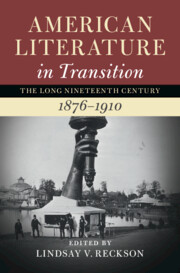Book contents
- American Literature in Transition, 1876–1910
- Nineteenth-Century American Literature in Transition
- American Literature in Transition, 1876–1910
- Copyright page
- Contents
- Contributors
- Series Preface
- Acknowledgments
- Chronology
- Introduction
- Part I Transitive States
- Part II Post-Reconstruction Aesthetics
- Chapter 6 Lyrics of the Color Line
- Chapter 7 Experimental Realisms
- Chapter 8 Species of Sentiment
- Chapter 9 The Microclimates of Regionalism
- Chapter 10 Racial Topographies and the Poetics of Mass Culture
- Part III Old Materialisms
- Part IV Immanent Techniques
- Index
Chapter 6 - Lyrics of the Color Line
from Part II - Post-Reconstruction Aesthetics
Published online by Cambridge University Press: 24 August 2022
- American Literature in Transition, 1876–1910
- Nineteenth-Century American Literature in Transition
- American Literature in Transition, 1876–1910
- Copyright page
- Contents
- Contributors
- Series Preface
- Acknowledgments
- Chronology
- Introduction
- Part I Transitive States
- Part II Post-Reconstruction Aesthetics
- Chapter 6 Lyrics of the Color Line
- Chapter 7 Experimental Realisms
- Chapter 8 Species of Sentiment
- Chapter 9 The Microclimates of Regionalism
- Chapter 10 Racial Topographies and the Poetics of Mass Culture
- Part III Old Materialisms
- Part IV Immanent Techniques
- Index
Summary
Poetry, often regarded as one of our most asocial genres, has had a special place in the development of what English professors now call “close reading,” in part because the poems often referred to as “lyric” – short, self-contained poems often with first-person speakers, and sometimes bearing a special relationship to song – could easily be collected and distributed, and were often understandable on their own terms, without outside knowledge or historical context. Some critics celebrated “close reading” of poetry as an especially “democratic” way of teaching and learning literature, because lyric poetry was thought to be “universal” – able to be unbound from particular historical or political contexts, or circumstances of social and economic class; appreciable for its musicality, its beauty, its rhythms, the feelings it evokes, above and beyond the particular circumstances in which it was produced.1
- Type
- Chapter
- Information
- American Literature in Transition, 1876–1910 , pp. 111 - 130Publisher: Cambridge University PressPrint publication year: 2022



